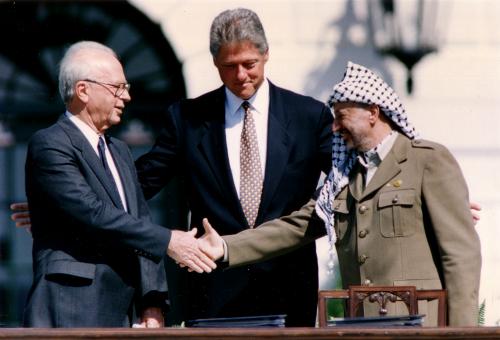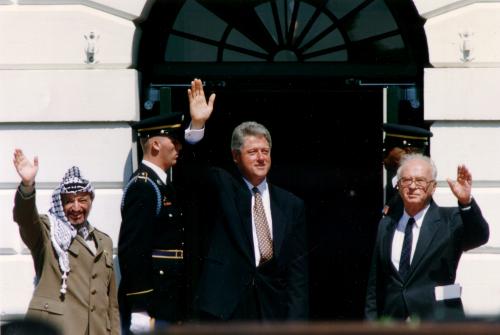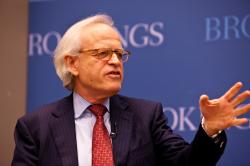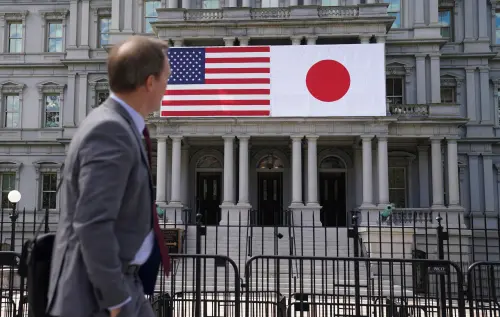Twenty-five years after the Oslo Accords were signed, writes Martin Indyk, the quest for that Holy Grail of Middle East peace never seems to end. It just reinvents itself. This piece originally appeared in The Atlantic.
In the annals of the Arab-Israeli conflict, it was a historic turning point. At least that’s the way it seemed at the time. On this day, 25 years ago, the Oslo Accords—a framework for an interim agreement between Israelis and Palestinians—were signed on the South Lawn of the White House. President Bill Clinton, the host of the ceremony, was unable to sleep the night before. He told his peace team, of which I was a member, that he had read from his Bible instead, from the book of Joshua with its detailing of the battle of Jericho. The next morning, Clinton donned a blue silk tie with a pattern of gold trumpets. For him, the trumpets symbolized the clarion call that precipitated the walls of Jericho crumbling, just like he hoped the walls of Israeli-Palestinian conflict would come tumbling down as a result of the agreement between the modern-day equivalents of the Hebrews and Canaanites.
The hundreds of dignitaries on the South Lawn on that sun-drenched fall morning were there to witness the historic handshake between PLO leader Yasir Arafat and Israeli Prime Minister Yitzhak Rabin. As Clinton’s Middle East adviser on the National Security Council, I had organized the signing ceremony. Still, few of us knew what was in the Accords. They had been negotiated behind the backs of Clinton and his peace team. Mahmoud Abbas, then Arafat’s deputy, claimed that even the Palestinian leader hadn’t read them. But like Clinton, those who bore witness cared less about the details than the symbolism. The handshake was meant to signify the moment when Israeli and Palestinian leaders decided to begin the process of ending their bloody conflict and resolving their differences at the negotiating table.
In a carefully choreographed scene, Clinton stood behind the two leaders with his arms outstretched as they shook hands, signaling the United States’s embrace of their agreement and his personal commitment to helping them fulfill the politically risky undertaking.Twenty-five years later, the conflict continues, marked by bloody outbursts of terrorism and violence, rocket fire and retaliations. Thousands of Palestinians and Israelis have died, many more have been injured. Since then, one American president after another has tried to end it. The Oslo process was supposed to have provided the blueprint, with its requirement for a series of confidence-building interim steps that would help Israeli and Palestinian leaders absorb the political costs of the difficult compromises needed finally to achieve peace. The Oslo Accords did not spell out those compromises; they did not provide for a Palestinian state, nor for a solution for Jerusalem, which both sides seek as their capital, nor for the Palestinian refugees who claim a “right of return.” They only provided that the final-status issues were to be negotiated and concluded within five years of the signing.
Final-status negotiations actually began in spring 2000, in the Clinton administration’s last year, more than seven years after the handshake on the South Lawn. The delay was the result of Prime Minister Netanyahu’s dilatory tactics. He had won a narrow victory by running against Oslo and then took up more than two years negotiating agreements for redeployment from parts of Hebron and 13 percent of the West Bank. He was succeeded by Ehud Barak, who preferred to negotiate with Syria first.
By that time, both the sweet and bitter fruits of Oslo had been harvested. Much of the cost of occupation was lifted from Israel’s back as the Palestinian Authority assumed responsibility for governing some 90 percent of Palestinians in the West Bank and Gaza, and the international community footed the bill. The Accords provided political cover for King Hussein of Jordan to conclude his peace treaty with Israel, and for several Gulf and North African Arab states to begin normalizing relations with the Jewish state. Syria’s President Hafez al-Assad concluded that he too was free to negotiate peace with Israel once Arafat had signed the Oslo deal. And Egypt’s peace with Israel was strengthened by President Hosni Mubarak’s active engagement in the effort to implement Oslo.
But when it came to relations between Israelis and Palestinians, trust had been severely eroded in the meantime. The Oslo Accords were silent on what should happen with Israeli settlements in the 60 percent of the West Bank Israel still controlled pending a final agreement. Accordingly, with final-status negotiations approaching, the settler hardliners pushed aggressively to expand the settlements by legal and illegal means in an effort to forestall any further withdrawal. At the same time, the Palestinian leadership had neither the will nor the capability to prevent terrorist attacks against Israelis perpetrated by Hamas and other splinter groups opposed to the Oslo Accords. Both sides felt betrayed. Instead of building confidence, these dynamics contributed significantly to each side’s questioning of the other’s intentions. In October 2000, mounting Palestinian frustration generated the intifada, or violent uprising, which in turn engendered Israel’s angry response.
Oslo as an interim, confidence-building process died on the battlefield of the five-year long intifada. But it gave birth to a new Oslo process: the effort to create a two-state solution in which an independent Palestinian state would live side-by-side but separated from the Jewish state (a concept that is nowhere mentioned in the Oslo Accords). This time, the United States was midwife rather than witness. From Camp David II to the Clinton Parameters, from the Bush Roadmap to the Annapolis Process, from Obama’s ’67 Lines to the Kerry Principles, successive administrations tried to fashion a rational solution to an irresolvable problem.The final-status negotiations that Secretary of State Kerry managed to forge by sheer force of will in 2013 revealed unbridgeable gaps on all the issues. For example, Netanyahu insisted on an IDF presence on the Jordan River and in the West Bank for at least three decades; Abbas rejected ever recognizing Israel as a Jewish state. The Israeli government claimed all of Jerusalem as its undivided capital; the Palestinians insisted that East Jerusalem had to be their capital. Netanyahu rejected admission of any Palestinian refugees to Israel; Abbas insisted that at least some be allowed to return. Less obvious, but no less real, was the decline in America’s ability to influence the outcome. With the interim approach discredited and the two-state goal unattainable, the “Oslo Process” died in 2014.
Then along came President Trump, determined to turn a dead process into “the Deal of the Century.” His plan has yet to be revealed but its purpose appears clear—to legitimize the status quo and call it peace. Trump has already attempted to arbitrate every one of the final status issues in Israel’s favor: no capital in East Jerusalem for the Palestinians; no “right of return” for Palestinian refugees; no evacuation of outlying settlements; no ’67 lines; no end of occupation; and no Palestinian state. And for good measure, no aid for the ungrateful Palestinians. Little wonder Trump has now shuttered the PLO legation in Washington. Since he has so effectively driven the Palestinians away from the negotiating table, who needs it?
Over 25 years, in shifting roles from witness to midwife to arbiter, the United States has sadly failed to help Israelis and Palestinians make peace, leaving them mired for the time being in what has essentially become a frozen conflict.
But the quest for that Holy Grail of Middle East peace never seems to end. It just reinvents itself. Perhaps when Mahmoud Abbas, Benjamin Netanyahu, and Donald Trump leave the scene, it will be time to try again. Perhaps then someone will dig up the video of that magical day in September 1993, when peace seemed within reach, and when an American president promised Israelis and Palestinians “the quiet miracle of a normal life.”







Commentary
The day Israeli-Palestinian peace seemed within reach
September 13, 2018